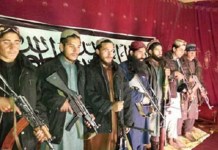The Rashtriya Rifles – Indian Army’s elite counter-insurgency battalion has been the backbone of operations in the militancy-hit regions of Jammu and Kashmir and has been at the forefront of ferociously combating the Pakistan-trained militants in J&K.
Indian All-Out Retaliation Against Pakistan Hindered By France and Russia?
“For a soldier, the heart normally is where he has served with honour and where he has gained great experience. Thus for me, one of the organisations closest to the heart remains the Rashtriya Rifles, commonly referred as the RR” writes Syed Ata Hasnain, a retired General of the Indian Army.
Rashtriya Rifles at the Handwara Encounter
As EurAsian Times reported earlier, it has only been two days since India lost two of its most decorated officers of the 21 Rashtriya Rifles battalion, besides two army personnel and a sub-inspector of J&K police in an encounter with terrorists in Handwara tehsil of Kupwara district in North Kashmir.
#ArmyCdrNC & all ranks paid homage to Col Ashutosh Sharma, SM**, Maj Anuj Sood, Nk Rajesh Kumar and L/Nk Dinesh Singh at BB Cantt. The gallant soldiers made #SupremeSacrifice in line of duty at Handwara on 02 May. Deepest condolences to the bereaved families.#Kashmir #IndianArmy pic.twitter.com/Xwx84KmurM
— Chinar Corps? – Indian Army (@ChinarcorpsIA) May 4, 2020
The team of five including four soldiers from 21 Rashtriya Rifles comprising Col Ashutosh Sharma (CO), Major Anuj Sood, Naik Rajesh Kumar, Lance Naik Dinesh Singh, and J&K Police Sub-Inspector Shakeel Qazi went incommunicado and later killed while carrying out a decisive onslaught against the hiding terrorists.
Wreath laying ceremony for India’s five bravehearts of Handwara Ops in Kashmir. Saluting their ultimate sacrifice for the nation. Jai Hind! #RIP pic.twitter.com/O9kigS9hRS
— Aditya Raj Kaul (@AdityaRajKaul) May 4, 2020
In the almost three-decades-long existence of the Rashtriya Rifles, India mourned the martyrdom of only the second Commanding Officer killed in a counter-insurgency operation.
Who are Rashtriya Rifles
In 2018, the Rashtriya Rifles celebrated its silver jubilee having neutralized over 16,300 terrorists, which then included 8,522 killed, 6,737 apprehended and 1,109 surrendered.
The RR unit was raised late in 1990 by the then Army chief Gen V N Sharma with Lt Gen P C Monkotia as its first Director-General. Initially, there were six such battalions, three in J&K and three in Punjab.
Later, all the Rashtriya Rifles battalions were moved to Jammu and Kashmir as the valley got entangled in a bloody conflict with Pakistan-trained militants creating havoc in the region.
With the motto, “dridhta aur virta” (translating to Resolute and Bravery) the force comprises 65 battalions divided into five companies—Romeo Force, Delta Force, Victor Force, Kilo and Uniform Force.
The Rashtriya Rifles being the star of the Indian defence services as the largest counterinsurgency force in the world is not an easy battalion to make one’s way to. One half of the unit comes from the Indian Army’s infantry, and one half from the rest of the Indian Army.
All individuals, prior to joining their respective units, must undergo a four-week rigorous pre-induction training at a Corps Battle School. It is followed by two weeks of ‘on-the-job’ training and a periodic refresher training cadre under sector arrangements.
Along with the coveted deputation of being a part of the most decorated organisation in the army, the recruited personnel receive 25% more salary than regular army soldiers and additional benefits that add up to the whole experience.
Rashtriya Rifles’ Involvement in J&K
In an attempt to ensure that India’s LoC divisions could perform their jobs i.e. engaging Pakistan, unhindered by guerilla action, the Rashtriya Rifles carry out search operations, conduct crackdowns, raid suspected hideouts of militants, make arrests and seize weapons.
The Rashtriya Rifles are themselves equipped with advanced weaponry, aircraft and other defence gear but the classic AK-47 remains their weapon of choice. The RR also has an exclusive network of local spies who are placed within militant organizations to provide ground-level intelligence.
Raised as a para-military force, the battalions of Rashtriya Rifles have been successful in their task to conduct multiple operations and bring back normalcy to many regions of the valley.
One of the battalion’s famed operations includes Operation Vijay in 1999, which was an armed conflict between India and Pakistan that took place between May and July 1999 in the Kargil district of Jammu and Kashmir and elsewhere along the LoC.
It is true that the primal goal of the battalion is to be at the forefront in counter-insurgency operations and eliminate terroristic activities, however, it simultaneously assists in grassroots development and winning over the locals by carrying out ‘Sadbhavana’ or Goodwill activities.
According to Col S D Goswami, the Rashtriya Rifles undertake a heterogeneous civic action program, intended at raising the standard of living, social, education and cultural betterment of the masses, implementing vocational education to youngsters, assuring their general empowerment, aiding to the education of women and a host of such people-centric initiatives are in progress,”.
According to exerts to the EurAsian Times, this is a major setback for Rashtriya Rifles and its counter-insurgency operations in Kashmir. However, the RR, being the force it is, would have already started tracking and hunting-down all involved with utmost ferocity.




